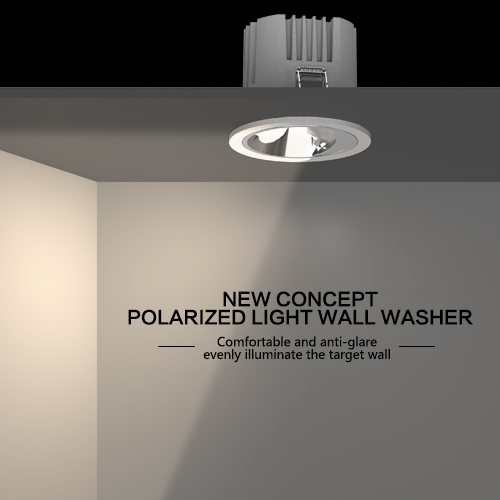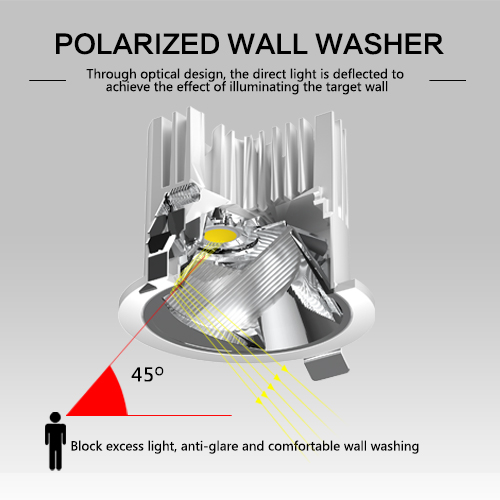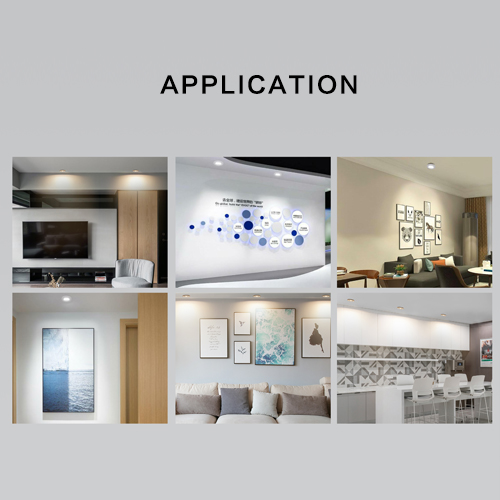What is the optimal distance between LED down lights?
LED down lights, with their high efficiency, energy efficiency, and long lifespan, have become a vital component of modern interior lighting systems. Widely used in residential, commercial, and office spaces, LED down lights are a popular choice for a variety of decor styles due to their simple design, uniform illumination, and easy installation.
When installing LED down lights, the distance between fixtures is a crucial factor. Proper fixture spacing not only improves lighting performance but also prevents light waste and insufficient illumination.
This article will explore the optimal distance between LED down lights in detail, analyzing the various factors that influence this distance to help readers make the right choice.

What are LED down lights?
LED down lights are lighting devices that incorporate an LED light source embedded in the ceiling or wall. They are typically round or square in design, with the main body of the fixture recessed into the ceiling, resulting in a simple appearance and bright light. The main advantages of LED down lights include:
· High efficiency and energy saving: LED down lights utilize LED technology, resulting in high energy efficiency and low power consumption, offering significant energy savings compared to traditional lamps. · Long Life: LED lamps can last over 25,000 hours, outlasting traditional incandescent and fluorescent lamps.
· Uniform Lighting: LED down lights provide even illumination, eliminating the shadows and uneven light patterns that can occur with traditional lamps.
· Adaptability: LED down lights can adjust brightness and light color to suit different spaces and functions.
Due to their flexibility and aesthetic appeal, LED down lights are widely used in various venues, including homes, offices, shops, hotels, and exhibition halls.

What are the Applications of LED Down Lights?
LED down lights can be used for a variety of lighting needs, such as primary lighting, auxiliary lighting, and accent lighting. In homes, LED down lights are often used as the primary light source in key spaces like living rooms, dining rooms, and kitchens, or as auxiliary lighting to supplement the illumination of specific areas. In commercial spaces, LED down lights are also widely used in display cabinets, billboards, and shopping malls to highlight specific areas or products.
What Factors Affect the Spacing Between LED Down Lights?
Several factors should be considered when determining the optimal distance between LED down lights. The following are the main factors that influence the spacing of LED down lights:
1. Ceiling Height
Ceiling height directly affects the spacing of LED down lights. Higher ceilings require wider spacing between luminaires, while lower ceilings require closer spacing. To ensure even lighting, the spacing between luminaires should match the ceiling height.
Mechanism of Influence:
· High ceilings (e.g., over 3 meters): Generally, a wider spacing is required to effectively diffuse the light and avoid concentrating it in one area, resulting in overly bright or dim areas.
· Low ceilings (e.g., 2.4 meters or less): A smaller spacing is required to ensure even light distribution throughout the room, avoiding overly diffused or dark areas.
2. Space Size and Function
The size and function of the space also play a significant role in determining the spacing of LED down lights. In small spaces, such as hallways or small bedrooms, luminaires are typically spaced closer together to increase light concentration. In larger, open spaces, such as living rooms and shops, a wider spacing is required to ensure even light distribution.
Impact Mechanism:
· Small Spaces: For rooms approximately 10-20 square meters, consider spacing LED down lights 1.5 to 2.5 meters apart to ensure that every corner is illuminated.
· Large Spaces: For larger spaces, such as living rooms or shops measuring 30-50 square meters, the spacing between luminaires may need to be greater, typically 2.5 to 3.5 meters, to avoid overly concentrated or dimmed light.
3. Lamp Power and Brightness
The power of LED down lights is closely related to brightness. Higher-power LED down lights provide higher luminous flux, thus providing a wider illumination coverage area. Conversely, lower-power LED down lights require shorter spacing to achieve the desired lighting effect.
Impact Mechanism:
· High-power LED down lights: Offer stronger illumination, can be spaced farther apart, and provide a wider light spread. Generally, the higher the luminaire power, the farther apart they can be spaced.
· Low-power LED down lights: Offer relatively weaker illumination and a smaller illumination coverage area, requiring shorter spacing to ensure that every area receives adequate light.
4. Beam Angle and Lighting Effect
The beam angle of LED down lights is also a significant factor influencing spacing. LED down lights with smaller beam angles produce a more concentrated light effect and are suitable for localized or accent lighting; whereas LED down lights with larger beam angles produce a more dispersed light effect and are suitable for large-area lighting.
Mechanisms of Influence:
· Small beam angles (typically between 15° and 30°): Suitable for focused lighting, requiring closer spacing between luminaires to concentrate light on a specific area.
· Large beam angles (typically between 40° and 60°): Suitable for broad lighting, requiring greater spacing between luminaires to ensure even light coverage.
5. Lighting Layout and Luminaire Type
The lighting layout also influences the spacing of LED down lights. Common layouts include grid, side-by-side, and diagonal. Different layouts require different light distribution and lighting effects, so the appropriate spacing should be selected based on the specific layout.
Mechanisms of Influence:
· Grid layout: Suitable for larger spaces, arranging luminaires at equal distances ensures even light distribution. The typical spacing between luminaires is between 2.5 and 3 meters.
· Side-by-side layout: Suitable for long or corridor-like spaces, the spacing between luminaires can be reduced, typically to 1.5 to 2 meters.
· Diagonal layout: Suitable for areas requiring accent lighting or high brightness, with a smaller spacing between luminaires.

How to calculate the standard spacing for LED down lights?
Generally speaking, there's no fixed "optimal" spacing for LED down lights; it varies depending on the space and needs. However, there are some commonly used industry standards that can serve as a reference. Here are a few common calculation methods:
1. General Spacing Calculation
· For rooms with an area of 10-20 square meters, the luminaire spacing can be set at 1.5-2.5 meters.
· For rooms with an area of 20-30 square meters, the luminaire spacing can be set at 2-3 meters.
· For rooms larger than 30 square meters, the luminaire spacing can be set at 2.5-3.5 meters.
These distances are based on typical home lighting needs and are applicable to LED down light installations in typical living spaces.
2. Adjust according to ceiling height
Ceiling height is an important factor when calculating spacing. The following are common recommended spacings based on ceiling height:
· Ceiling heights under 2.4 meters: The recommended spacing between luminaires is 1.5-2 meters to ensure even lighting.
· Ceiling heights between 2.4 and 2.8 meters: The recommended spacing between luminaires is 2-2.5 meters.
· Ceiling heights above 2.8 meters: The recommended spacing between luminaires is 2.5-3 meters.
3. Calculate wattage and beam angle
In addition, luminaire wattage and beam angle also have a direct impact on luminaire spacing. Taking typical home or commercial lighting as an example, the following are reference spacings for several common wattages:
· 5-10 watts: Suitable for lighting smaller areas, with a recommended spacing of 1.5-2.5 meters.
· 10-20 watts: Suitable for lighting medium areas, with a recommended spacing of 2-3 meters. Power of 20 watts or more: Suitable for large areas or high-brightness lighting needs. A spacing of 2.5-4 meters is recommended.
Why should we avoid overly clustering downlights?
Close spacing between downlights can lead to overly concentrated light, resulting in uneven lighting. In this case, some areas may appear overly bright, while others appear dim. Excessive concentration can also increase eye discomfort, especially after prolonged exposure to the lighting.
Will excessive spacing between luminaires result in insufficient light?
Excessive spacing between luminaires can lead to insufficient light in some areas, especially in areas with high light requirements, such as desks and workbenches. This can create dark areas or localized insufficient light. Therefore, when arranging luminaires, consider both lighting needs and light coverage, and avoid excessive spacing between luminaires.
What are the advantages of buying LED lights from a Chinese factory like Huari?
Buying LED lighting from a Chinese factory like Huari offers several advantages. First, you benefit from factory-direct prices, which are lower than buying through intermediaries. Second, we offer vast customization capabilities, whether it’s product design, branding, or packaging.
Third, our production capacity—over 1 million units monthly—ensures timely delivery. Finally, our rich manufacturing experience and ISO-certified quality management make us a trustworthy long-term partner.
